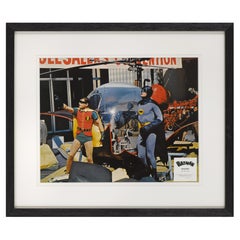French Lobby Card
Clint Eastwood The Good The Bad The Ugly - Original 1966 French Lobby Card
Located in London, GB
The Good The Bad The Ugly - Original 1966 French Lobby Card
Vintage 1966 French Lobby Card:
A
Category
1960s Figurative Prints
Materials
Paper, Cardboard
$275
H 8 in W 10 in D 0.1 in
La Grande Illusion
Located in London, GB
This is an exceptionally rare original French lobby card used to advertise the film in French
Category
Vintage 1930s French Posters
Materials
Paper
Goldfinger
Located in London, GB
Original French Lobby card for the film Goldfinger. It was the third James Bond film and the third
Category
Vintage 1960s French Posters
Materials
Paper
Bullitt (1968)
Located in London, GB
Bullitt (1968) - FRAMED
Lobby Card (9 X 12 Inches)
Original French Lobby Card
A still from
Category
Vintage 1960s Posters
Materials
Paper
„The French Connection“ Original American Lobby Card of the Movie, USA 1971.
Located in Cologne, DE
Original American Lobby Card of the Movie „The French Connection“ USA 1971 Director: William
Category
1970s Modern Interior Prints
Materials
Color
$718
H 11.03 in W 13.98 in
„Notre Dame De Paris“ Original Lobby Card of the Movie, France/Italy 1956.
Located in Cologne, DE
Original Lobby Card of the Movie „Notre Dame De Paris“ France/Italy 1956 Director: Jean Delannoy
Category
1950s Modern Interior Prints
Materials
Color
$958
H 9.14 in W 13.15 in D 0.01 in
Recent Sales
Goldfinger
Located in London, GB
Original French Lobby card for the film Goldfinger. It was the third James Bond film and the third
Category
Vintage 1960s French Posters
Materials
Paper
Batman
Located in London, GB
Original French lobby card for the 1966 film Batman.
This film was based on the Batman television
Category
Vintage 1960s French Posters
Materials
Paper
Get Updated with New Arrivals
Save "French Lobby Card", and we’ll notify you when there are new listings in this category.
French Lobby Card For Sale on 1stDibs
Find many varieties of an authentic French lobby card available at 1stDibs. Frequently made of paper, animal skin and lacquer, every French lobby card was constructed with great care. Whether you’re looking for an older or newer French lobby card, there are earlier versions available from the 20th Century and newer variations made as recently as the 20th Century. When you’re browsing for the right French lobby card, those designed in Regency styles are of considerable interest.
How Much is a French Lobby Card?
The average selling price for a French lobby card at 1stDibs is $696, while they’re typically $249 on the low end and $6,240 for the highest priced.
More Ways To Browse
French Gilt Armchair
Antique Gold Armchair
Captains Armchair
Gold Hollywood Regency Chair
Hollywood Regency French Chairs
Leather Club Dining Chair
Leather Captain Chairs
French Regency Desk
1963 Denmark Chair
Art Deco Executive Desk
Captains Chair Office
Regency Chairs Ebonized
1940s Art Deco Club Chair
1950s Executive Desk
Scandinavian Executive Desk
Scandinavian Art Deco Club Chairs
James Bond Sean Connery Poster
Eight Regency Dining Chairs




